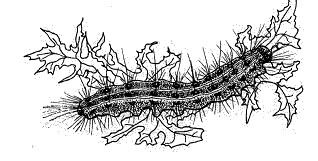 |
Adult European gypsy moths are not seen as often as the caterpillar stages (larvae), which at times can appear in seemingly endless numbers. The female moth is a dirty white color and has dark bands across the forewings. It is stoutly built and covered with dense, furry hairs. Although it has a wingspan of about 2 inches it flies feebly. The male is darker and smaller but is a strong flier. The dreaded caterpillar doesn't look dreadful. It is about 2-1/2 inches long, and has 5 pairs of blue spots and 6 pairs of red spots along its back. The red spots make it easy to distinguish between a gypsy moth caterpillar and that of the common Eastern tent caterpillar, which lacks these spots. Also, gypsy moth caterpillars do not live in colonies constructed of silky tents.
Their Growth Stages
In September the female moths lay 75 to 1,000 eggs on the bark of trees, on stone walls, woodpiles, or even on your garden furniture. These egg masses are covered with velvety, buff-colored hairs and sit dormant until next spring. They can survive temperatures as low as minus 25°F.
Next Spring, in late April or early May, just as trees are beginning to leaf out, the eggs hatch into larvae, or tiny caterpillars. These larvae climb upward on tree trunks toward the leafy branches, laying down long filaments of silk as they travel about. Believe it or not, these tiny caterpillars can “fly” from tree to tree for their meals. They’re bristling with long, hollow hairs, and they lay down long strands of silk as they feed; as a result, they’re easily carried long distances by the wind. Finally, they settle down to feed in the leaf canopy. They steadily enlarge in size and by mid-July they are well fed and ready to pupate. By this time the caterpillars start to move up and down the trees; they climb down to hide during the day and climb back up at night to feed. At last they pupate in their daytime hiding places. The pupal stage lasts about 2 weeks. The moths emerge in August and September, mate, and lay more eggs. Only 1 generation occurs each year.

